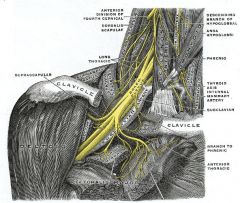![]()
![]()
![]()
Use LEFT and RIGHT arrow keys to navigate between flashcards;
Use UP and DOWN arrow keys to flip the card;
H to show hint;
A reads text to speech;
26 Cards in this Set
- Front
- Back
|
What is the 'axilla'?
|
Another name for the armpit. The space that is sandwhiched between anteriorly and posteriorly to the shoulder joint.
|
|
|
Which muscle lies over the medial wall of the axilla?
|
The 'serratus anterior' (muscle that you can see when stretching, three lines to it curving around the side of the body)
|
|
|
Where is the 'serratus anterior' muscle?
|
It's the muscle that you can see when stretching, three lines to it curving around the side of the body.
|
|
|
It's the muscle that you can see when stretching, three lines to it curving around the side of the body.
|
The 'serratus anterior'
|
|
|
The nerve plexus for the upper limb is derived from the _______ ____ whose segmental origin is almost completely from the ____. It is called the _______ plexus.
|
Ventral rami, whose segmental origin is almost completely from the neck. It is called the brachial plexus.
|
|
|
This plexus streams over the first rib into the axilla
|
Brachial plexus
|
|

|
.
|
|
|
(sing) 'The acromion's connected to the ________'
NB Acromion is part of the scapula |
'The acromion's connected to the, clavicle'
|
|
|
Where does the head of the humerus fit into?
|
The 'glenoid cavity' of the scapula
|
|
|
Which body part fits into the glenoid cavity of the scapula?
|
The head of the humerus
|
|
|
The greater and lesser tubercles of the humerus are associated with muscles that pull on the distal end of the humerus T/F
|
F, the tubercles are associated with muscles that pull on the proximal end of the humerus
2155090111 |
|
|
The tubercles of the humerus can be traced down the humerus for a short way as two raised ridges. These bony ridges are called the ______ of the greater and lesser tubercles.
|
Crests of the greater and lesser tubercles
|
|
|
A groove is formed between the tubercles and their corresponding crests. This is called the...
|
...intertubercular groove
|
|
|
As one goes down the humerus, it begins to thin and is a point where the bone often breaks. What is this area known as?
|
The surgical neck of the humerus
NB This is still very high up on the bone, just distal to the main 'ball'/head of it |
|
|
This marks the region into which the cape-like deltoid muscle is inserted
|
The 'deltoid tuberosity'
|
|
|
What is the type of cartilage that covers the glenoid cavity? (Part of the scapula)
|
Articular cartilage (NB this covers lots of joints, and when it wears down it leads to a type of arthritis called 'osteoarthritis'
0733100111 |
|
|
Which part of the scapula does the pectoralis minor connect to?
|
The 'coracoid process'
|
|
|
What is the name for the joint between the acromion and the clavical? What type of joint is it?
|
The 'acromioclavicular joint'. It's a synovial joint.
|
|
|
What is the name for the joint at the medial end of the clavical? What's special about it?
|
It's called the 'sternoclavicular joint'. It's a synovial joint with a sepcial 'disc' that allows articulation (this is the only articulation between the trunk and the pectoral girdle (The clavicals and scapulas) that's bone based)
|
|
|
What is the 'pectoral girdle'?
|
The clavicals and scapulas
|
|
|
The clavicals and scapulas combine to create a structure known as the...
|
...pectoral girdle
|
|
|
Both the acromioclavicular and sternoclavicular joints are primary cartilaginous joints T/F
|
F! They are synovial
1417100111 |
|
|
On which ribs does the pectoralis minor arise from?
|
The middle three true ribs (Ribs III, IV and V)
(: |
|
|
The pectoralis MINOR can be used as an accessory muscle for breathing T/F
|
T. It is only used as such when the pectoral girdle is *stabalised*. Patients sometimes do this by clinging onto the side of the bed, or by putting their hands on their hips.
|
|
|
Comment on the connections of the subclavius.
|
Arises from the upper surface of the first rib, and is then inserted into the under-surface of the clavicle
|
|
|
On a radiograph of a *child*, a large 'fan' or 'sail' shaped object can be seen in the mediastinum, and protruding into the lungs. What is this object?
|
The thymus gland
|

